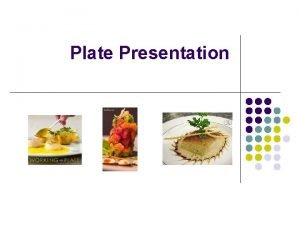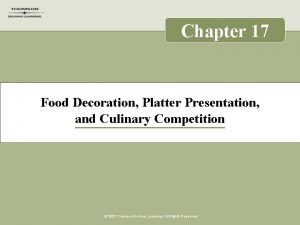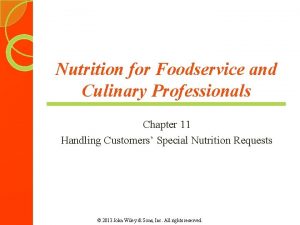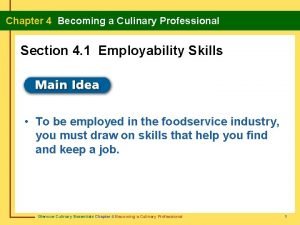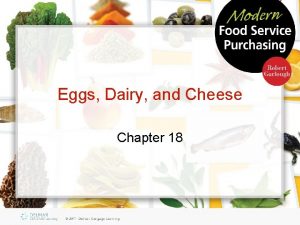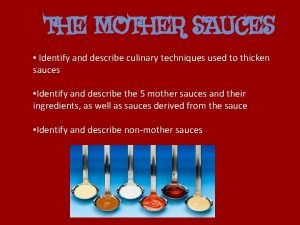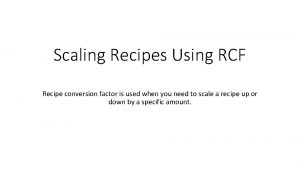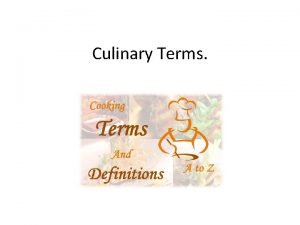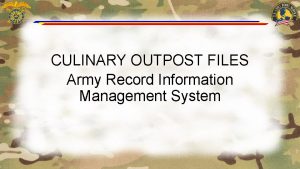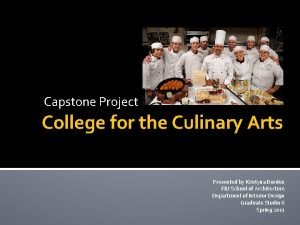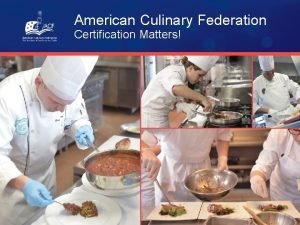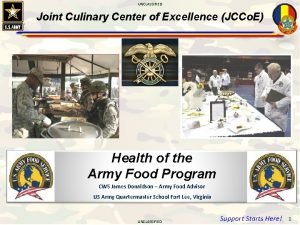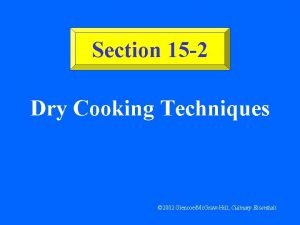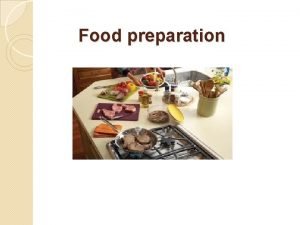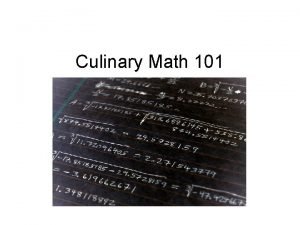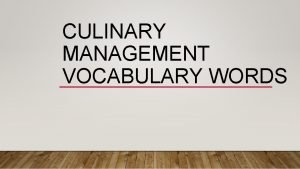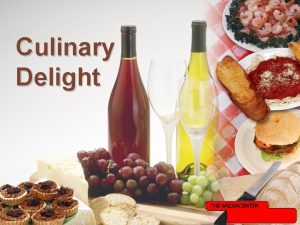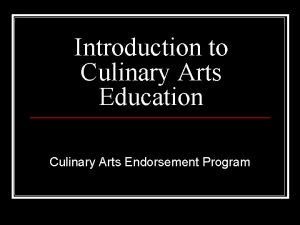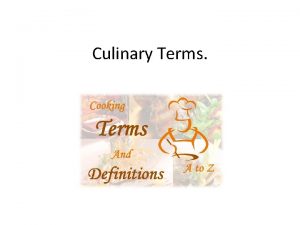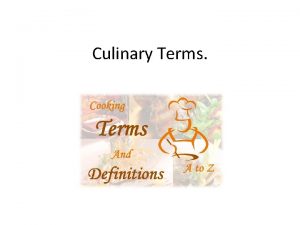Chapter 17 Food Decoration Platter Presentation and Culinary













































- Slides: 45

Chapter 17 Food Decoration, Platter Presentation, and Culinary Competition © 2007 Thomson Delmar Learning. All Rights Reserved.

The Purpose of Decoration and Presentation • To provide eye appeal • To provide a professional appearance

Coating Agents • Purpose – Preserve the food – Improve its flavor – Enhance its appearance – Act as an accompanying sauce or moistening agent

Gelatin • Extracted from skins, connective tissue of meat, and the bones of younger animals • When mixed with water, is transparent and almost colorless • Is sold in a dehydrated form as a granule and a fragile sheet • Can be purchased as clear or brown color • Is used to “set” such items as jellies, mousses, and savory aspics

Gelatin • Points to consider: – Avoid fresh fruits containing the enzymes bromelain, ficin, papain, and actinidin – The infusion of large amounts of sugar will inhibit setting properties – When using dry powder, mix with cold water first for 3 to 5 minutes to moisten before adding the hot liquid for melting – Can be melted and rechilled several times before it loses its thickening ability

Gelatin • Points to consider: – Boiling will dilute its thickening properties – Will take twice as long to dissolve when using cream or milk – Always combine sugar and gelatin before dissolving – Always soak gelatin leaves in cold water to soften before adding to a hot liquid

Gelatin • Points to consider – 4 sheets of leaf gelatin equal 2½ teaspoons (7 g) of powdered unflavored gelatin. – 1 envelope of powdered unflavored gelatin (¼ oz) is equal to 2½ teaspoons (7 g) and can be added to 2 cups (473 m. L) of liquid to establish a standard firmness – In its dry form, gelatin has an indefinite shelf life

Gelatin-Setting Agents • Isinglass: a type of gelatin extracted from the air bladders of fish, particularly sturgeon • Carrageen: a type of gelatinous thickening agent derived from seaweed that grows off the coasts of Scotland Ireland • Agar or agar-agar: the Malay name for gum; native to Japan

Aspic Jelly • True aspic jelly as made by Carême was a clarified stock made with the knuckle and feet of young veal – Natural gelatin being extracted from the collagen – Very expensive method for obtaining gelatin – Not done today unless an occasion warrants the expense

Aspic Jelly • Modern version: – Uses a well-clarified stock with the addition of commercially purchased leaf or dried gelatin • Creates an acceptable aspic for pâtes and terrines, sliced meats, brushing on cold fish and shellfish, and most other presentations in the cold kitchen

Aspic Jelly • Third Version – Adding pure gelatin product to clear water • Has become popular in recent years • Is cost saving—time, labor, skill • It coats without interfering with the flavor of the food

Uses for Aspic Jelly • As a stabilizer in salad dressings • To fill a pastry encrusted pâté, to allow the slice to appear whole • As a binding agent for mousses, parfaits, pâtés, and purées • To brush on any sliced roasted meat, poultry, or game for enhanced presentation • Brushed on sliced terrines, pâtés, or galantines

Uses for Aspic Jelly • For brushing on individual pieces of food that will be the focal point of platters or plates • For coating the bottom of plates as a background for food • For coating the bottom of a platter as a base for presenting food • Cut into shapes or chopped, and spread on an accompanying dish or platter

Uses for Aspic Jelly • Layered into a vegetable terrine to allow it to set and carve easily • For setting any cold sauce, other than chaud-froid, that would be served on a plate or platter • Applied as a finishing shine onto large food items for display on a buffet, such as whole poached salmon or trout, whole roasted racks of lamb or beef, and whole roasted geese or ducks

Uses for Aspic Jelly • To coat the bottom of molds, before being filled with a cold purée, for trapping a design inside • Used at varying strengths to coat a host of ingredients for use in competitions • To assist with the application of rubs and crusting on the outside of food items before being carved or served • Used to strengthen delicate food items

Techniques for Applying Aspic • Aspic does not need to be heated; it only needs to be melted to slightly warm, never hot • Cool a portion of the warmed aspic over cold water, and when it reaches optimum consistency, begin to use it • Use the excess liquid aspic to warm up the hardening aspic, returning it to the correct consistency for coating

Techniques for Applying Aspic • Do not leave the aspic sitting in the iced water • Stir the aspic gently to avoid setting—aggressive stirring will introduce unwanted bubbles • Gently transfer aspic to new bowls often to avoid lumping • Do not boil the aspic because this will weaken its setting qualities • Avoid accumulation of debris in the aspic

Chaud-Froid • Chaud-froid means “first hot then cold. ” • Classically made with any mother sauce • Uses: – When plating a large quantity of cold appetizer that requires a plate sauce – Saucing plates and platters for culinary competitions – Flooding plates or platters to create a different color background for food presentation

Chaud-Froid • Uses: – Flooded plates or platters can have shapes carefully cut from within and contrasting sauces inlaid in their place – Can be imitated in the cold sauce section of the garde manger using the principle of the classic mayonnaise colée – Can be used to bind vegetables, fruits, salad materials, or fish or shellfish for timbales, socles, or compound salad presentations

Chaud-Froid • Uses: – To coat or semicoat individual pieces of food; however, the food does not have to be poached as it was in the past – Can be allowed to set on a flat tray, cut into attractive shapes and used to garnish plates or platters of food – Can be used for coating large hams, turkeys, and large fish such as salmon for decorative centerpieces – It makes a very pure white canvas for the chef to decorate the buffet

Techniques for Using Chaud-Froid • Techniques are similar as for aspic • Generally, the pieces coated tend to be larger than those for aspic • It was commonly used to coat a whole item before portioning • Successful coatings are done by dipping and flooding

Displaying Food for Competition • Rules: – Identify the main components or protein items of the platter and choose complementary ingredients to accompany them – When methods of preparation of the meats are complicated, it is appropriate to select easier accompaniments – Cooking methods should vary throughout the presentation and reflect the diversity of skill of the chef

Displaying Food for Competition • Rules: – Textures used should vary throughout the platter utilizing all available to the chef • Smooth, coarse, solid, soft, liquid, crisp, crunchy – Colors should reinforce the perception of freshness, quality, and well-executed methods of cooking – Shapes and sizes of garnishes should suit the size of the platter and demonstrate well-executed knife skills

Displaying Food for Competition • Rules: – Flavors and seasonings should be well distributed around the platter • • • Spicy with bland Rich with lean Smoky and salty with sweet Sweet with sour Sweet with spicy • Any garnishing should add color, texture, taste, and interest to the plate

Displaying Food for Competition • Rules: – Carving should be accurately executed, and the shingling between slices should be exact – The carved food should create interestingly shaped lines – These lines should have perfect form and create flow and interest to the overall design of the platter

Displaying Food for Competition • Rules: – Equal attention should be given to all components of the platter – The platter should have a focal point – The flow of the food on the platter is the result of well-balanced food in unison and provides a pleasing pathway to the focal point

Specialty Presentations • Have unique characteristics that will affect planning and layout • The accompaniments for any platter can be included as part of the platter design, or as part of the garnish • Accompaniments can also be served to the side in small dishes that have their own serving utensils

Specialty Presentations • Buffet items should have signage to identify main items and accompaniments

Cheese Presentations • Always include a representative example from different classifications – 6 to 12 would be appropriate • The layout should guide the order of tasting – Milder to softer – Younger to stronger – Firmer – Riper

Cheese Presentations • When served as a tasting, few items should be served as accompaniments • It is customary to serve crackers, bread, and water • When served as part of a buffet, the cheeses should be selected from a range of styles according to the customer demographics • The cheese should be cut appropriately for the number of guests, making self-service easier

Caviar Presentations • Create a presentation that clearly defines the portion that the guest should take • Serve from original packing container, glass bowl, or silver dish – Place on a large platter, elevate with ice pedestal, and surround with small spoons or croutons that contain the portion of caviar that is intended for each guest

Gravad Lox Presentations • For ease of service: – Place a garnish of two or three slices in between each portion: crouton, lemon slice, or pickle slice works well – The salmon could be rolled up with one of its accompaniments, such as cream cheese, then presented – Accompaniments such as cream cheese, pickles, capers, sliced sweet onions, and lemon wedges would be served aside, or on the platter

Fruit Platter Presentations • Always select seasonal varieties that are sufficiently ripened • Choose different textures, colors, and flavors. • Should be peeled or partially peeled, portioned into bite-size pieces or slices • Whole fruit can be attractively arranged into designs, or carved into interesting shapes for a centerpiece or focal point

Vegetable Platter Presentations • Always select fresh and crisp vegetables that are in season • Peel and cut into shapes that are easy to eat, as well as interesting to observe • Mix shapes and colors to form attractive patterns • Gourds and squashes work well whole and uncut, or carved as the pièce montée • Appropriate dips and dressings are served as accompaniments

Charcuterie Presentations • Should represent the whole of the classification • Variety should give the platter many interesting and complementary shapes, textures, and flavors • The focal point can be an arrangement of partial sausages and salamis positioned in the back center area of the display • Slices can be shingled forward into lines that appear to have originated from a larger solid part • Accompanying chutneys, relishes, pickles, and crusty bread should be served on the side

Deli Tray Presentations • Should contain a combination of sliced meats and cheeses, accompanied by relishes, salad items, condiments, and breads • Can be prepared in advance and dropped off at a location without the need of service staff

Culinary Competitions • Categories – Cooking Professional/Student Cold Platters – Cooking Professional/Student Cold Plated – Patisserie/Confectionery – Showpieces – Team Buffet – Hot Food Competitions

Culinary Competitions • Reasons to compete: – – It promotes camaraderie among chefs It provides inspiration to young professionals It provides a great way for chefs to network It provides an arena for the chef to showcase skills and techniques to the public – It offers educational rewards – It promotes growth, research, and development within the industry

Culinary Competitions • Reasons to compete: – It sharpens the skills and techniques of the chef – It allows for high levels of creativity within the industry – It encourages the use of good workmanship and nutritionally sound cooking – It teaches economy and judicious use of products

Planning for Competition • Confirm dates and location • Read current rules and make sure they are fully understood • Always ensure that food products are going to be available to you where you are and where you are going • Research what is current and what, if anything, that the judges might be looking for

Planning for Competition • Concentrate on showing the judges the skills and techniques that have been mastered • Plan a schedule for practices • Plan a progression chart indicating where dishes should be by a specific time in order to see progress • Stick to the practice schedule and always stay focused • Seek professional advice from colleagues or other seasoned competitors to eliminate unforeseen pitfalls

Planning for Competition • Draw and write everything down from its conception to the final plate presentation • Keep the chosen dishes or presentation within the skill and technique ability of the competitor • As competition time approaches, follow a strict regimen of nutrition and exercise

Planning for Competition • Have checklists for all food, materials, equipment, uniforms, and all other personal items • Leave plenty of time to get to destination and set up • Follow the entire rules specific to the competition category and be prepared for any changes and equipment failures that may occur

Planning for Competition • Common Mistakes – Poor execution of basic fundamentals – Making “food show” food instead of “customer food” – Creativity supercedes sensibility – Sloppy workmanship – Poor composition – Inconsistent sizes

Planning for Competition • Common Mistakes –Unappetizing food – Incorrect garnish and portion count, and portion size – Sloppy aspic work – Poor layout
 Balance in plating
Balance in plating Platter presentation
Platter presentation Chapter 5 surface decoration vocabulary master
Chapter 5 surface decoration vocabulary master Silver platter doctrine
Silver platter doctrine Hard disk uses and function
Hard disk uses and function Runion pronunciation
Runion pronunciation Healthy mind platter
Healthy mind platter What are the 6 elements of design
What are the 6 elements of design Chapter 11 culinary nutrition
Chapter 11 culinary nutrition Chapter 4 becoming a culinary professional answers
Chapter 4 becoming a culinary professional answers Chapter 7 activity guide culinary
Chapter 7 activity guide culinary Chapter 14 culinary math
Chapter 14 culinary math The little decoration at the end of a letter stroke is a
The little decoration at the end of a letter stroke is a Almada negreiros maternity
Almada negreiros maternity Text decoration blink
Text decoration blink Maths decoration
Maths decoration The shaded areas on the map above of south africa indicate
The shaded areas on the map above of south africa indicate Decoration stressed syllable
Decoration stressed syllable Font and faces in multimedia
Font and faces in multimedia Prose is architecture not interior decoration
Prose is architecture not interior decoration Unit 2 food food food
Unit 2 food food food Grazing food chain diagram
Grazing food chain diagram Nutrition for foodservice and culinary professionals
Nutrition for foodservice and culinary professionals Nutrition for foodservice and culinary professionals
Nutrition for foodservice and culinary professionals Nutrition for foodservice and culinary professionals
Nutrition for foodservice and culinary professionals Culinary crossword 9.1 eggs and dairy
Culinary crossword 9.1 eggs and dairy Smallest anteroposterior diameter of the pelvic inlet
Smallest anteroposterior diameter of the pelvic inlet 4 maneuvers of leopold
4 maneuvers of leopold Strand for cooking
Strand for cooking Chef culinary conference
Chef culinary conference Ratio for roux
Ratio for roux What is rcf in culinary
What is rcf in culinary Lahc counseling
Lahc counseling 7 parts of a standardized recipe
7 parts of a standardized recipe Culinary school terms
Culinary school terms Arims labels
Arims labels Culinary arts study guide
Culinary arts study guide Culinary jeopardy
Culinary jeopardy Strand for culinary arts
Strand for culinary arts Acf certification
Acf certification Joint culinary center of excellence
Joint culinary center of excellence Section 15-2 dry cooking techniques
Section 15-2 dry cooking techniques Prepare food definition
Prepare food definition Culinary crossword 2.1 fire safety answers
Culinary crossword 2.1 fire safety answers Culinary math
Culinary math Rancidity meaning
Rancidity meaning
